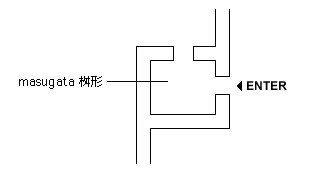Notes
1. Rules. The Catch-22 Youko finds herself in is not uncommon. High school regulations (kousoku) typically regulate the length of girl's skirts, the length of boy's hair, prohibit the wearing of jewelry and the coloring of hair. A student with hair that is not naturally black is often suspected of having dyed it, or is labeled a haafu (mixed race). [return]
2. Private girl's school. The difference between public and private high schools in Japan is approximate to the difference between state and private universities in the United States. There is no open enrollment in either case; students gain acceptance primarily based on entrance exam scores. Over a quarter of students in Japan attend private high schools. [return]
3. Interior wall. Ono is describing a masugata, a simple defensive structure in Japanese castles that forced anyone entering the castle to turn at a right angle immediately upon passing through the gate. This prevented a headlong charge from breaking into the center of the courtyard, even if the outer gate were breached. [return]

(From the Japanese Architecture and Art Net Users System)
4. Mochi is a rice cake made traditionally by pounding steamed glutinous rice in a wooden mortar. Dried, it resembles hard paraffin; cooked it becomes a sticky, pasta-like starch. [return]
5. The Setonaikai, or "Inland Sea," is bounded by Honshu (the main island), and Shikoku and Kyushu islands. Hiroshima, at the southern end of Honshu, is the largest port on the Setonaikai. The atomic bomb was dropped on Hiroshima on 6 August 1945. The events Matsuyama is relating took place in July. [return]
6. Showa Emperor. Japanese emperors are referred to posthumously by the name of their era, or nengou. The era name of Emperor Hirohito's reign (1926-1989) is Showa ("shining peace"), so he is now referred to as the Showa Emperor. The current reign of his son, Akihito, is called Heisei ("achieving peace"), though while living he is simply referred to as Tennou ("Emperor") or Tennou Heika (His Royal Majesty). [return]
7. Showa 20. Calendar years in Japan are counted according to nengou, the reign of the emperor, as well as the western (Gregorian) year. Japanese have no problem keeping track both of the current nengo and the Gregorian year, but referring to a previous nengou requires a bit of calculation. As 1926, the year of Hirohito's enthronement, counted as Showa 1, subtracting 1925 from the current Gregorian year determines the Showa year. So 1945 - 1925 = Showa 20. [return]
8. Rip Van Winkle. The original reference is to the Japanese fairy tale Urashima Taro. One day while fishing Urashima Taro rescues a turtle. The turtle, it turns out, is kin to the Dragon King. As a reward Urashima is taken to the king's palace under the sea where he is welcomed by Princess Otohime and bestowed with every luxury a man can imagine. But eventually he grows homesick for his old life. As a going-away present, Otohime gives him a locket and tells him never to open it. When Urashima returns to his village, everything has changed. Although Urashima has been gone for only a few weeks, in the human world 300 years has passed. Curious, he opens the locket. In a flash, he turns into a very old man, for in the locket had been stored all his missing 300 years. [return]
9. Emotional vampire. Ono's more creative expression is satori no youma, or a demon who forces you to realize things about yourself and then feeds off this knowledge while it destroys you. [return]